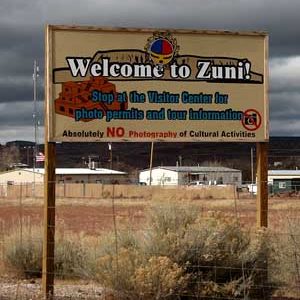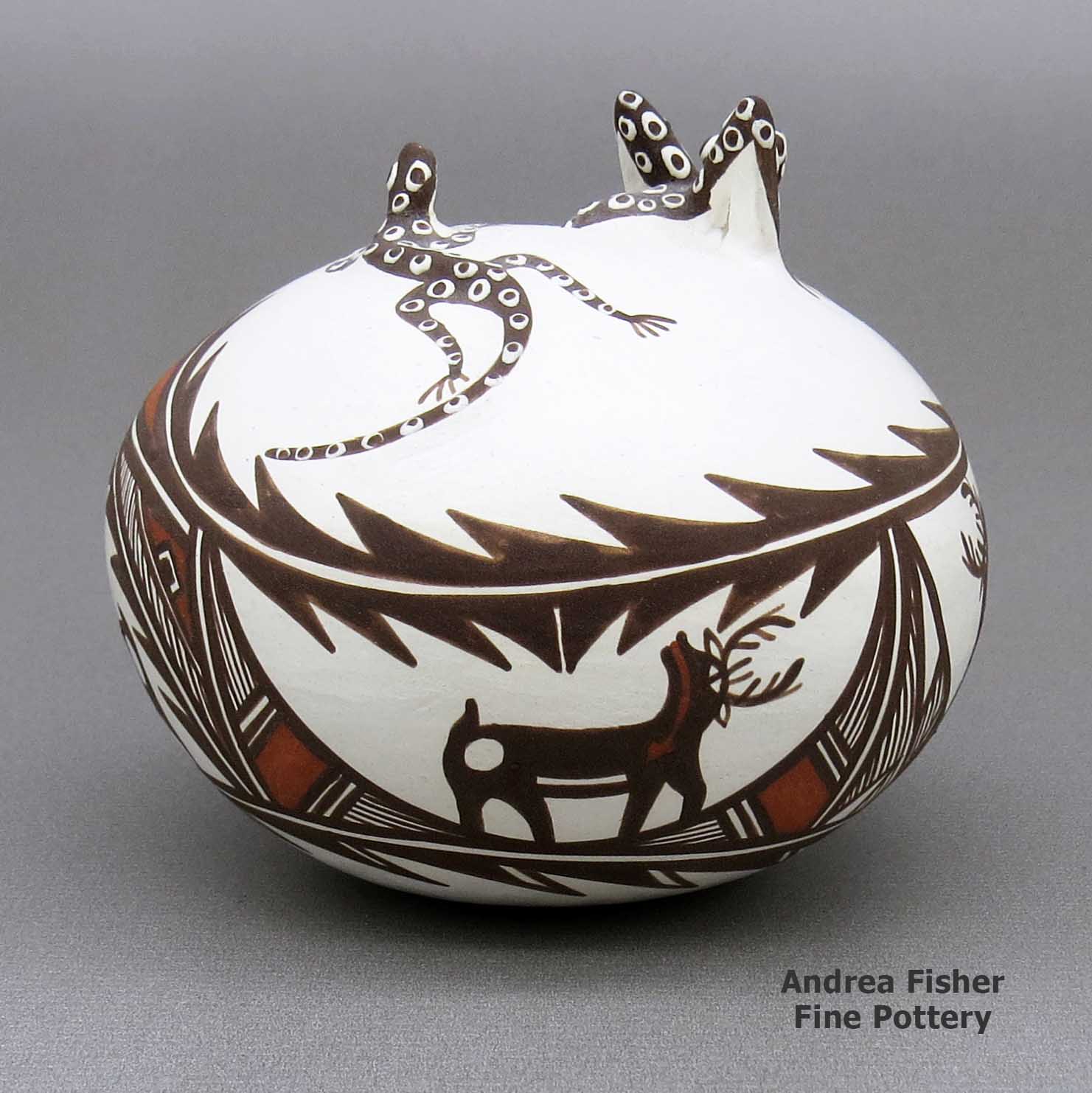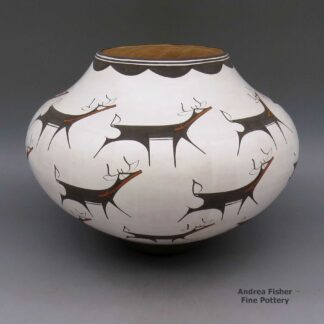| Dimensions | 3 × 3 × 2.75 in |
|---|---|
| Condition of Piece | Very good, normal wear |
| Date Born | 2000 |
| Signature | Noreen Simplicio Zuni, with a copyright symbol |
Noreen Simplicio, zzzu3b513, Seed pot with deer-with-heart-line design
$395.00
Polychrome seed pot decorated with three lizard appliques and painted with a four-panel traditional Zuni deer-with-heart-line and geometric design
In stock
- Product Info
- About the Artist
- Home Village
- Design Source
- About the Shape
- About the Design
- Teaching Tree
Brand
Simplicio, Noreen
A daughter of Mike and Carmelita Simplicio born into Zuni Pueblo in 1964, Noreen Simplicio says her love affair with clay began as a little girl making mud pies and mud pots. When she was old enough, she enrolled in the ceramics classes taught by Jennie Laate at Zuni High School. From the moment she first touched Jennie's clay she knew she wanted to be a potter for the rest of her life. A few years later she studied some with Angelina Medina, an award-earning Zuni/Acoma sculptor and potter.
Noreen entered her first pottery competition in 1988 and earned an Award of Excellence. That August she was a featured New Artist at the Santa Fe Indian Market. In 1989 she entered six pieces in the pottery competition at Santa Fe. She earned 4 First Place ribbons, a Second Place ribbon and a Third Place ribbon.
In 1990 Jennie Laate retired from teaching at Zuni High and Noreen assumed the job for 2 years before passing the torch to Gabriel Paloma. In that 2 year period she taught more than 100 Zuni students how to make traditional Zuni pottery.
Since then Noreen has earned many awards at venues like the Santa Fe Indian Market, the Gallup InterTribal Ceremonial and the Heard Museum Guild Indian Arts Fair & Market. She earned Best of Division ribbons at the Heard Museum twice (2003 and 2005) for her miniatures.
Noreen makes polychrome white ware and orange ware cornmeal bowls, jars, seed pots, effigy pots, lizard bowls, figurines and miniatures. Her favorite designs include fine line, lizards, deer-in-his-house, tadpoles, salamanders, birds, feathers, terraced clouds, rain and carved village scenes.
A Short History of Zuni Pueblo

"K'ynánas'tipe stretched his legs to the four great seas, then gradually he settled down and called out, 'where my heart and navel rest, beneath them mark the spot and build your town there for that shall be the midmost place of Mother Earth.' As he squatted over the middle of the plain and the valley Zuni, he drew in his legs and his feet marked the trails leading outward like the radiating web of a spider. The fathers of the people built on this spot and rested their fetishes there." - Frank H. Cushing, Outlines of Zuni Creation Myths, pp. 428-9
Archaeologists have dated some sites on the Zuni Reservation back to the Paleo-Indian Period, more than 4,500 years ago. During the Archaic Period (2,500 BCE to 0 CE), the forebears of the Zuni were hunter-gatherers and just beginning to develop agriculture. The Basketmaker Period (0 CE to 700 CE) saw agriculture become more developed and the Zunis make their first pottery. The Pueblo I Period (700 CE to 1100 CE) saw an expansion of the population and larger settlements were built in the Zuni River area along with the development of the first painted Zuni pottery.
The Pueblo III Period (from 1100 to 1300 CE) saw further population growth in the Zuni River area and a shift from small houses to larger, plaza-oriented villages. The Pueblo IV Period (1300 to 1500 CE) was the time of significant bad weather, great drought and the beginning of the flood of Athabascans and Utes. Many tribal groups were forced out of the Four Corners area and relocated to locations near the Rio Grande, Rio Puerco, Zuni River and Little Colorado River. The main Zuni Pueblo was founded during this time but there were several other large villages in the area, too.
In 1540 Francisco Vasquez de Coronado arrived at the gates of Hawikuh, at the time one of the larger of seven Zuni pueblos. He first approached the pueblo at the end of a four-day religious festival. The Zuni chief had spilled a line of corn meal across the ground before the entrance to the pueblo, meant to signify to the Spanish that they shouldn't cross the line and enter the village yet. Coronado interpreted that line of corn meal as an act of war and immediately ordered his soldiers to attack.
Coronado was almost killed in the fighting (Zuni warriors had dropped a large rock on him, knocking him off his ladder and almost crushing him) but his soldiers did finally win the battle. As Coronado and his men brought horses and sheep with them, they were probably the first such livestock the Zunis had ever seen. The gold the Spaniards were looking for: it turned out to be Sikyátki Polychrome bowls and jars, yellow clay gifts from the Hopi people to the Zuni people.
The Zuni chief did give Coronado a refugee from the Plains tribes, someone who'd somehow made his way as a lone traveler to Hawikuh. That refugee was supposed to be a guide for Coronado and his men but he was instructed by the Zuni chief to take Coronado into the Plains and get him lost there. When Coronado finally realized that, more than a year later, he ordered the guide executed, then turned his men around and headed back to Zuni and Mexico.
When he passed by Zuni in 1542, Coronado left three Mexican Indians behind with the tribe. They most likely informed the tribal leaders of the extent of the Spanish domain in Mexico and the power they exercised there.
Except for a couple passing exploratory expeditions, the Zuni pueblos were left alone until the 1620s. Then came the friars who oversaw the construction of a mission church at Hawikuh in 1629. At first the Zuni people were friendly with the priests but with the forced labor requirements and forced religious conversions, the priests wore that welcome out quickly. Relations had changed drastically for the worse by the time of the Pueblo Revolt of 1680. Zuni warriors killed the priests and burned the missions but they preserved the relics and icons the priests had brought from Spain.
The tribe built a village near their fortress atop Dowa Yalanne and prepared to defend their people and way of life against the Spanish army. When Don Diego de Vargas arrived with troops in 1692, he attacked the fortress twice and failed. Then he negotiated with the Zuni war chief and was allowed to ascend to the top of Dowa Yalanne. He was given a tour of the property and he found many relics from the destroyed missions there. With that knowledge, he arranged a peace between the Spanish and the tribe. Between 1693 and 1700 the tribe consolidated all their small villages into what is now the Pueblo of Zuni.

Photo courtesy of Ken Lund, Creative Commons Attribution-Share Alike License 2.0 Generic
Traditional Zuni Designs
Anthropologists say the Zuni people have been isolated for so long, there are no referrents to where their language came from. The images they paint on pottery, though, show some signs of cross-pollination with the Hopi, Acoma, Laguna and some of the Rio Grande pueblos.
Among those images are the heart-line, as in deer-with-heart-line. At some pueblos, that has become bear-with-heart-line and antelope-with-heart-line. Sometime around 1890, a Laguna potter made the journey to Zuni to learn from a potter there how to make better pottery. He stayed only a few months before returning to Laguna, via Acoma. He brought back better knowledge of mixing the clay, making the paints and painting the designs. Among those designs was the deer-with-heart-line.
At the time of first Spanish contact, there were seven Zuni pueblos spread out along the Zuni River. By about 1720, that was reduced to one. When the American archaeologists arrived, they set about excavating almost every abandoned village they could find. In the process, many pieces of ancient pottery came to light. That's where the names Matsaki Polychrome and Red-on-buff (matte paint on white and red slips, produced from about 1375 CE to about 1700 CE), Kwakina Polychrome (glaze paint on a white slip, produced from about 1325 to about 1400) and Heshotauthla Black-on-red and Polychrome (glaze decorations, produced from about 1275 to about 1400) came from. A primary difference between Kwakina and Heshotauthla designations is the color the inside of the bowl is slipped with. The decorations on both are painted with lead glaze colors and are taken from the same design library, which includes many designs common to the Mogollon Highlands in eastern Arizona (such as St. Johns Polychrome), although the designs tend to be not as well executed.
The advent of Matsaki Polychrome and Red-on-buff coincides with the entrance of an immigrant community from the north: the land of the Hopi. With them came the basic design library of what we now refer to as "Sikyatki Polychrome." Production of Kwakina- and Heshotauthla-style pottery dropped off quickly after the arrival of those who produced the Matsaki styles. It was around that time, too, that the Zuni villages around the Zuni Mountains were abandoned and the people pulled back to the pueblos along the lower Zuni River.
After Spanish contact and conquest, the Zunis were reduced to about one-tenth their population by Spanish diseases and labor practices. Before too long, they were gathered together in one village near the bank of the Zuni River. Their image catalog changed, too. When the American archaeologists and ethnologists came, they removed virtually every artifact of Zuni history they could dig up or find otherwise. Then they spirited it all away to storerooms on either coast, where most of it remains in boxes in dingy basement rooms today.
In 1986, Josephine Nahohai and several members of her family traveled to Washington DC and explored the basement storage shelves of the Smithsonian Institute, copying every ancient Zuni shape and design they found into their notebooks. When they returned to Zuni, their drawings became the basis for many of what are now referred to as traditional Zuni designs. Among those designs are symbols for mountains and forest, and images of frogs, tadpoles, dragonflies, serpents and rainbirds. Other Zuni potters have since visited other storerooms of ancient Zuni pottery and brought drawings of those shapes and designs back to the pueblo, too.
About the Seed Pot
It was a matter of survival to the ancient Native American people that seeds be stored properly until the next planting season. Small, hollow pots were made to ensure that the precious seeds would be kept safe from moisture, light, bugs, reptiles and rodents.
After seeds were put into the pot, the small hole in the pot was plugged. The following spring the plug was removed and the seeds were shaken from the pot directly onto the planting area.
Today, seed pots are no longer necessary due to readily available seeds from commercial suppliers. However, seed pots continue to be made as beautiful, decorative works of art.
The sizes and shapes of seed pots have evolved and vary greatly, depending on the vision of Clay Mother as developed through the artist. The decorations vary, too, from undecorated white, buff or red seed pots to multi-colored painted, carved, applique and sgraffito designs, sometimes with inlaid gemstones, micaceous clay and silver or clay lids.
Because of the multitude of shapes and sizes, the name "seed pot" is generally reserved for pieces with tiny openings.
Appliqués
An appliqué is a clay figure formed separately and then added to another clay piece. Without using appliqués, it would be next to impossible to create a storyteller or a friendship bowl or a lifestyle pot. Some potters sculpt ear of corn appliqués while others sculpt figures or flowers or lizards, serpents, bugs or birds. Their use may be a relatively recent development but they can be found in use in most pueblos.
Zuni Pueblo Teaching Tree
Disclaimer: This "teaching tree" is a best effort on our part to determine who the potters are in this group and arrange them in a generational order.
The pottery tradition at Zuni Pueblo almost died out until Daisy Hooee (granddaughter of Nampeyo of Hano, Hopi-Tewa) took on the job of teaching pottery at Zuni High School in 1960. She was recruited for the job by Catalina Zunie, a Zuni potter who had spent several years just trying to get pottery on the school curriculum. Daisy also spent a year working with Catalina to become a consummate Zuni potter herself before she started teaching.
There have been several teachers at Zuni High since then and for some students, learning from their parents (who were former Zuni High students) has helped to strengthen the tradition. This diagram is subject to change should we get better info.
- Daisy Hooee Nampeyo taught 1960-1974
- Jennie Laate taught 1974-1990
- Carlos Laate
- Agnes Peynetsa
- Anderson Peynetsa & Avelia Peynetsa
- Anderson Jamie Peynetsa
- Ashley Peynetsa
- Dominic Laweka
- Priscilla Peynetsa & Daryl Westika
- Daria Westika
- Gaylon Westika
- Caylon Westika
- Brian Tsethlikai and Yvonne Nashboo
- Eileen Yatsattie






